Six-barreled 106-mm anti-tank self-propelled artillery M50 Ontos
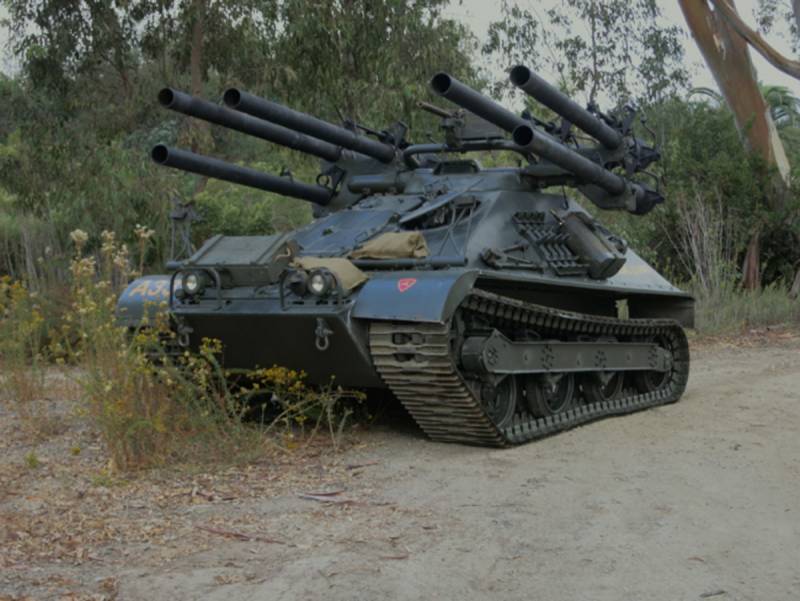
Before the advent of anti-tank guided missile systems, recoilless rifles were one of the main means of combating armored vehicles on the battlefield. Such artillery systems in the post-war period were developed and put into service in the USA, Great Britain, the USSR and China.
The main advantages of recoilless guns are their lower weight and relatively low cost compared to classic anti-tank guns. At the same time, recoilless guns lost in range and accuracy of fire and rate of fire, and the jet stream ejected from the rear nozzle and compensating for recoil poses a great danger to personnel and unarmored military equipment.
American 75-106 mm recoilless guns, operated in the 1950s-1970s
In the 1950s and 1970s, the US military operated the 75mm M20 and 106mm M40 recoilless rifles.
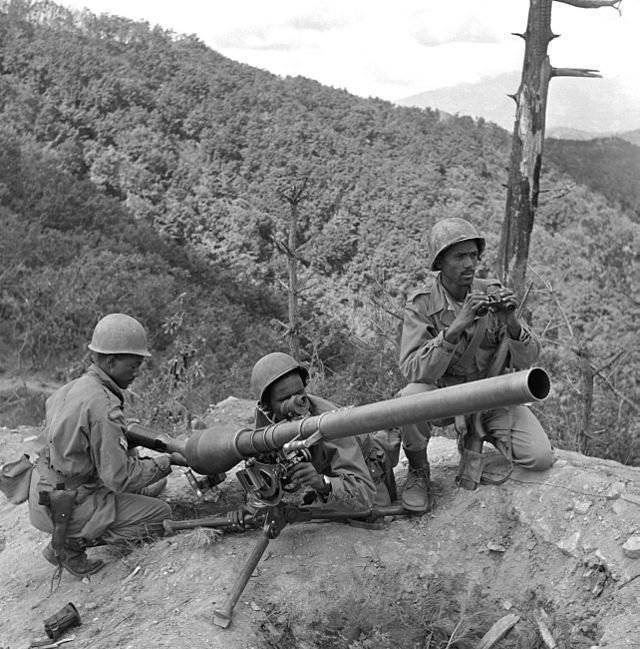
75 mm M20 recoilless rifle in Korea
At the time of its appearance, the 75-mm M20 recoilless rifle in the infantry units of the American army was an anti-tank weapon of the company and battalion level and, with a mass of 52 kg, could be transported to the battlefield by calculation forces. Most often, the gun barrel was mounted on a Browning M1917A1 machine gun of 7,62 mm caliber.
For the M20, there was a wide range of ammunition, including a cumulative projectile with armor penetration up to 100 mm, fragmentation projectile, smoke projectile and buckshot. An interesting feature of the M20 ammunition was that the shells had ready-made rifling on the leading belts, which, when loaded, were combined with the rifling of the gun barrel. Effective firing range tanks did not exceed 500 m, the maximum firing range of a high-explosive fragmentation projectile reached 6500 m.
In connection with the mass production of heavy tanks IS-3 and medium T-54 in the USSR in 1953, the 106-mm M40 recoilless rifle with an anti-tank cumulative projectile firing range of 1350 m (effective about 900 m) entered service. The maximum firing range of an 18,25-kilogram high-explosive fragmentation projectile is 6800 m. The armor penetration of the first cumulative projectiles was within 350 mm, later this figure was increased to 470 mm.
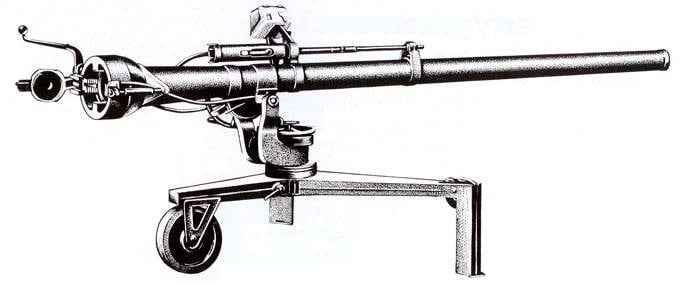
106 mm M40 recoilless gun
The rotary and lifting mechanisms of the gun are equipped with manual drives. The carriage is equipped with three sliding beds, one of which is equipped with a wheel, and the other two with folding handles. For sighting on top of the gun, a 12,7 mm M8 sighting machine gun is installed, which uses special ammunition for firing with ballistics corresponding to the trajectory of a 106 mm HEAT projectile. At the distance of an aimed shot, fire was opened from a sighting machine gun with the corresponding guidance adjustment. The trajectory of the 12,7 mm bullet was controlled thanks to a well-marked tracer. When a bullet hit its target, it exploded, giving a bright flash and a cloud of smoke.
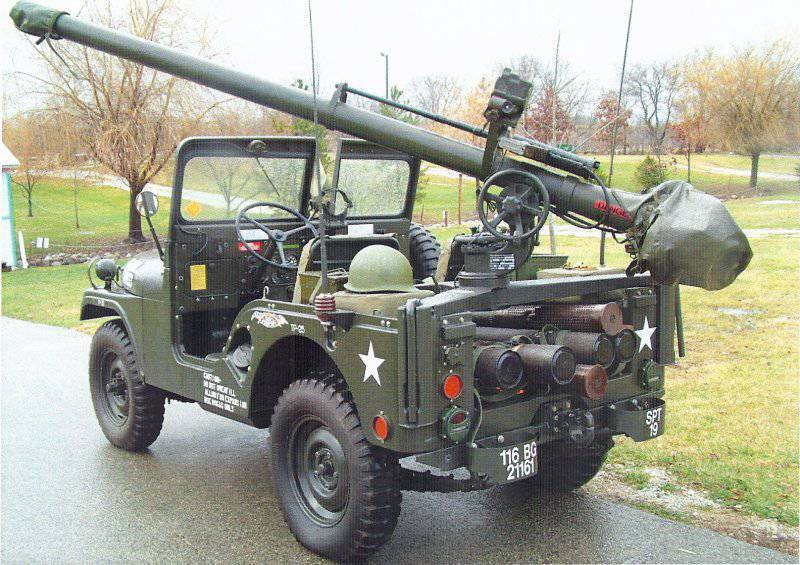
Taking into account the total length of 3404 mm and the weight of the 209 kg gun, the M40 gun was much more often installed on various vehicles compared to earlier American recoilless ones. Most often these were light off-road vehicles.
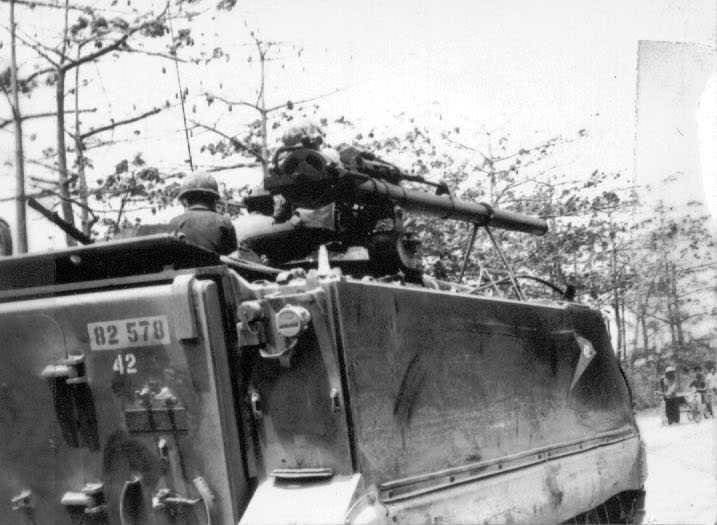
Sometimes these recoilless rifles were armed with various tracked and wheeled transporters. So, in Vietnam, the American army used the M113 armored personnel carrier with 106-mm recoilless rifles as a fire support vehicle.
106 mm anti-tank self-propelled artillery M50 Ontos
The most famous combat vehicle armed with M40 recoilless rifles was the American M50 Ontos anti-tank self-propelled artillery mount. Initially, the Ontos was conceived as a highly mobile tank destroyer that could be transported by military transport aircraft that the US Air Force had in the 1950s. If necessary, the rapid transfer of such anti-tank weapons to the required area was envisaged.
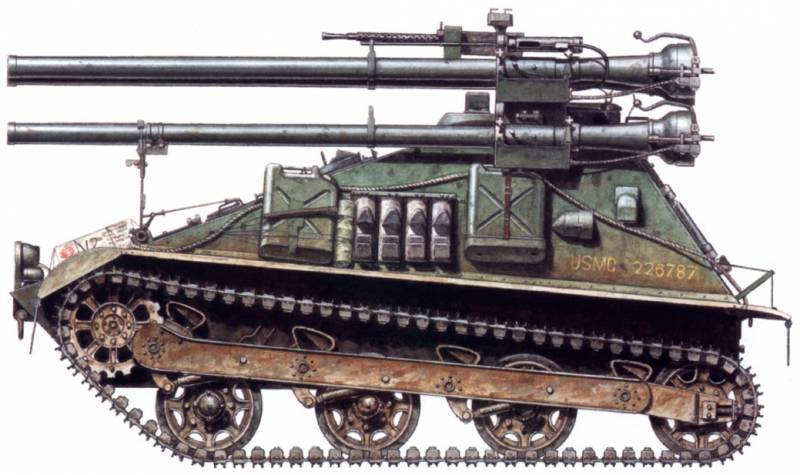
Tank Destroyer M50 Ontos
The anti-tank self-propelled guns, in addition to the unusual name (“Ontos” is translated from Greek as “Thing” or “Object”), had weapons atypical for vehicles of this purpose - six 106-mm M40A1C recoilless guns located outside on the sides of the turret, four 12,7-mm sighting (ammunition load 90 rounds) and one 7,62-mm machine gun Browning 1919A4 (ammunition load 1000 rounds) for self-defense against infantry and firing at air targets.
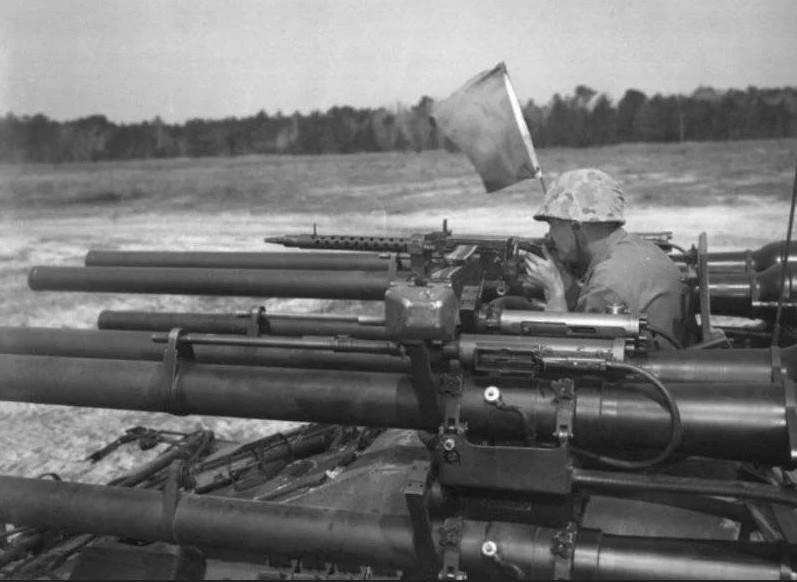
This weapon option was chosen in connection with the desire to provide the ability to fire several aimed shots in a short time. Since it took about 40 seconds to load the M20 gun, Allis Chalmers decided to increase the rate of fire by using six barrels. After a volley at the enemy, the self-propelled gun had to move to a safe place, where the guns were reloaded. The total ammunition load was 18 unitary 106-mm rounds.
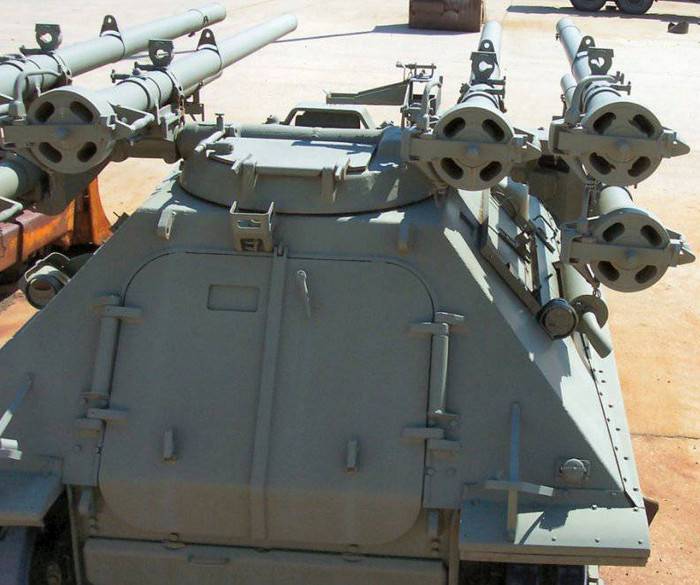
Tank Destroyer M50 Ontos, rear view
To reduce the cost in the design of the tank destroyer M50 Ontos, automobile units were widely used: a 6-cylinder gasoline engine General Motors Model 302 with a capacity of 145 hp. With. from a 2,5-ton army truck and an Allison hydromechanical transmission that transmits torque to the tracks. Some American authors write that in 1963, in order to increase mobility, some of the machines were equipped with a more powerful eight-cylinder Chrysler HT-361 engine and new type caterpillars, the mileage of which was increased from 2400 km to 4500 km. The upgraded sample received the designation M50A1.
The suspension system was designed in such a way that all its elements were located outside the car body.
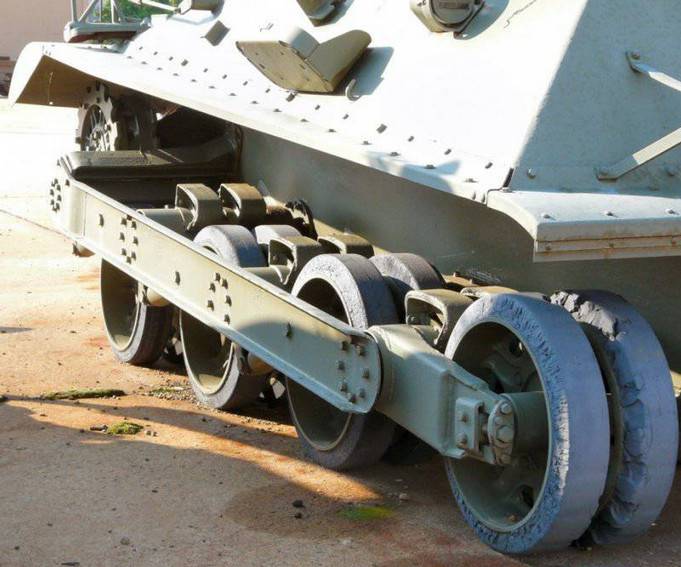
On each side there were four road wheels connected via balancers to torsion shafts attached to the sides of the hull. The drive wheels were located in front. Track width - 508 mm.
In front of the car were located the engine-transmission and control compartment. The hull was welded from 13 mm armor, which provided reliable protection against armor-piercing rifle-caliber bullets. The upper frontal sheet had a slope of 71°. The bottom is made of 6 mm armor plate.
A small rotating turret was located in the upper part of the hull. The six-barreled gun mount was symmetrically mounted on a horizontal shaft passed through the turret, thereby ensuring the vertical guidance of the guns. The guidance mechanisms of the gun mount had manual drives. The angle of horizontal guidance of the guns was 40 ° to the right and left of the longitudinal axis of the machine.
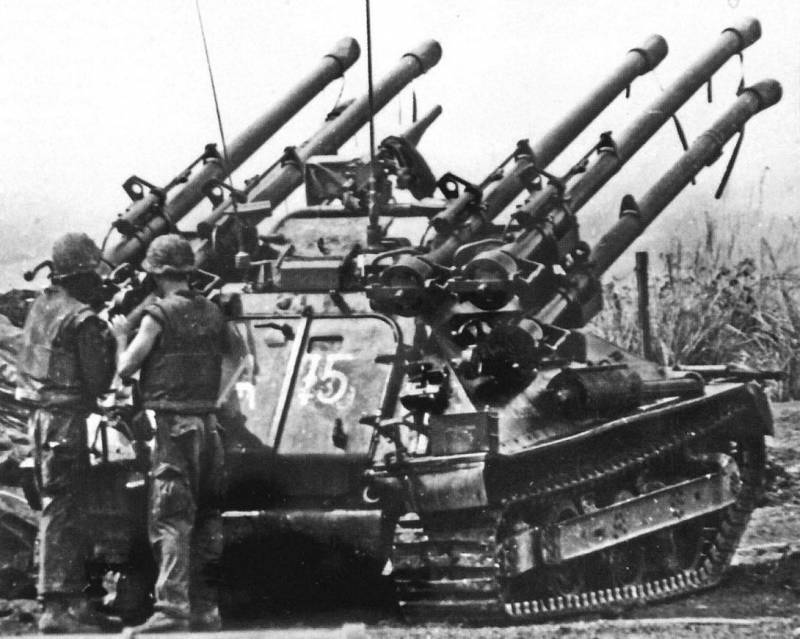
The elevation angle of the guns reached +20°, the angle of declination -10°. The two guns could be quickly removed from the vehicle to fire from the ground.
When equipped, the M50 Ontos tank destroyer weighed 8,63 tons and was very compact: length - 3828 mm, width - 2900 mm, height - 2133 mm. On the chassis, the car could accelerate to 48 km / h. The machine had a low specific pressure, which ensured good patency on soft soils.
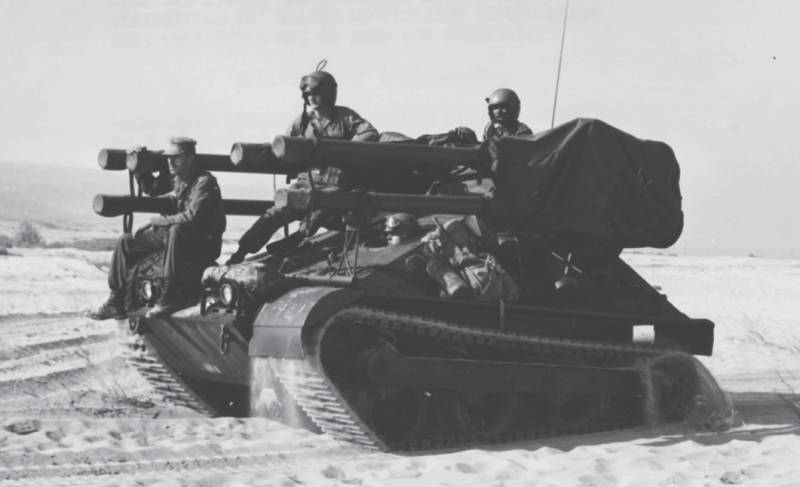
Cruising on the highway - up to 240 km. The height of the overcome wall reached 0,76 m, the width of the ditch - 1,37 m. Without preparation, it was possible to force a water barrier 0,6 m deep, after preparation - 1,3 m deep.
The crew consisted of a driver, loader and commander, who also served as a gunner. Personal weapons The crew were M3A1 submachine guns of 11,43 mm caliber.
Testing, series production and commissioning
Preliminary testing of the first prototype, known as the T165, began in 1951. In 1955, after the construction and testing of various models, a modified version of the T165E2 received official approval from the military, after which Allis Chalmers began mass production of this machine. On the basis of "Ontos" it was supposed to create a series of tracked combat vehicles: a self-propelled mortar, a self-propelled anti-aircraft gun and a light armored personnel carrier. A self-propelled gun project was also developed, armed with two revolver-loading recoilless rifles, which made it possible to fire several shots at a high pace and eliminated the need to leave the vehicle to reload. However, these plans were not implemented.
Initially, the contract provided for the construction of 1000 self-propelled guns. But the army command refused to accept the Ontos into service. The order came from the Marine Corps, which needed a light, passable tank destroyer that did not take up much space on landing craft and was suitable for landing on an unprepared coast.
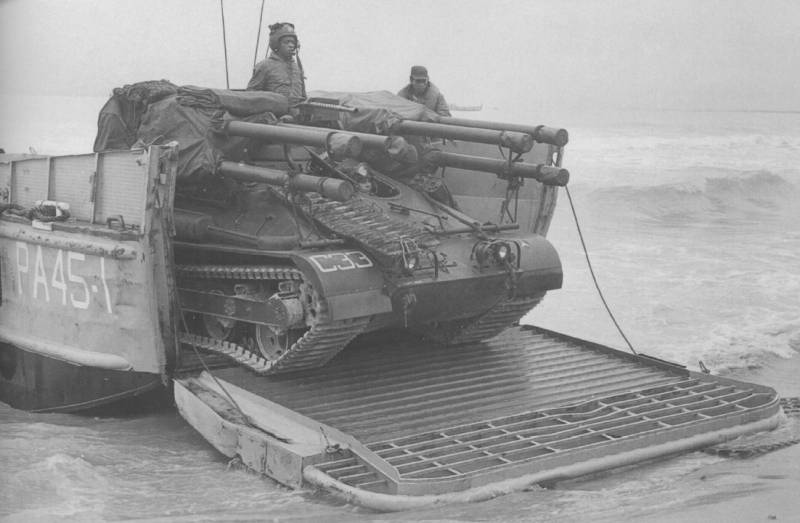
Serial construction of tank destroyers M50 was carried out in 1955-1957. In total, taking into account pre-production copies, 321 cars were produced. The first unit equipped with such self-propelled guns was recognized as combat ready in 1956.
"Ontos" entered the anti-tank battalions, which included three companies of three fire platoons. The platoons were equipped with "heavy" and "light" squads. There were three combat vehicles in the "heavy" section, and two in the "light" section.
Service and participation in hostilities
In the first years after being put into service, the USMC command worked out the methodology for the combat use of the Ontos, landing and interaction of anti-tank battalions with other units. In the course of maneuvers and training firing, it became clear that a self-propelled gun armed with recoilless rifles was outdated even at the stage of adoption and had little chance of winning in a direct collision with modern tanks. There were some favorable options when operating against heavy enemy armored vehicles from an ambush. In addition to fighting tanks, recoilless multi-barreled self-propelled guns were considered as a means of fire support for infantry. But in this case, the effective firing range of a high-explosive fragmentation projectile at a bunker-type point target did not exceed 2700 m.
For the first time in combat, the Ontos were involved in 1965 during Operation Power Pack, undertaken to overthrow the left-wing government of the Dominican Republic that had come to power.
After the US Marines landed in South Vietnam, the upgraded M50A1 self-propelled guns took an active part in the hostilities from early 1965 to mid-1969. Foreign sources claim that at the end of 1965 there were 65 Ontos in Vietnam. Of these, 45 vehicles were part of the 3rd anti-tank battalion and a smaller number - in the 1st anti-tank battalion of the USMC. Several self-propelled guns were also on board the landing craft on standby, to reinforce the landing units if necessary.
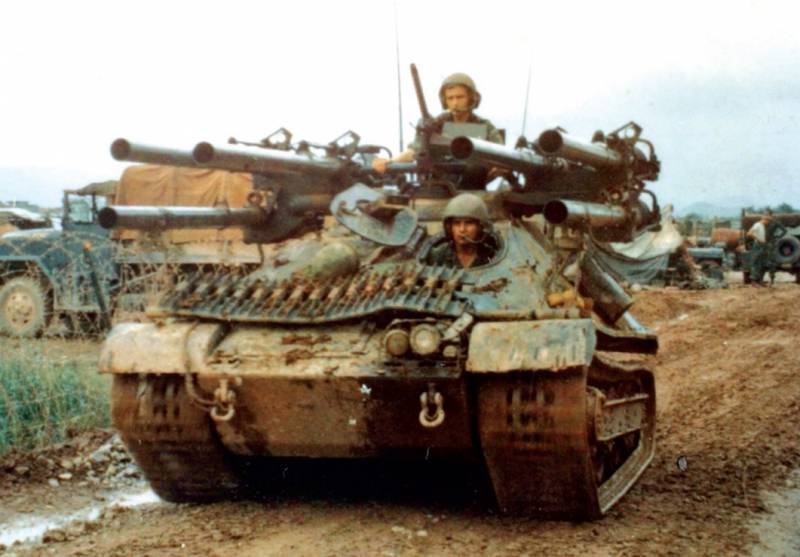
SAU M50A1 in Vietnam
The memoirs of US Marines who fought in Southeast Asia in the late 1960s say that the command of the USMC largely underestimated the combat potential of the Ontos in terms of their ability to fight enemy infantry.
Self-propelled guns turned out to be especially effective when repelling Viet Cong attacks in the jungle, when firing was carried out with grape-shot shells that mowed everything in their path at a distance of up to 400 m. At the same time, the crews showed miracles of ingenuity, placing up to 30 artillery shots inside the hull. High-explosive fragmentation shells, which were used to destroy manpower and destroy light field fortifications, also showed themselves well.
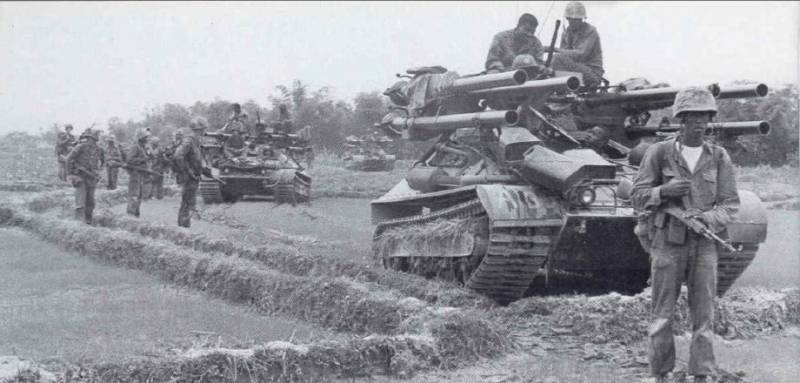
At the initial stage of the American presence in South Vietnam, light self-propelled guns were actively used to escort transport convoys, defend remote bases, and protect airfields. For operations at night, some of the machines were equipped with night vision devices and searchlights.
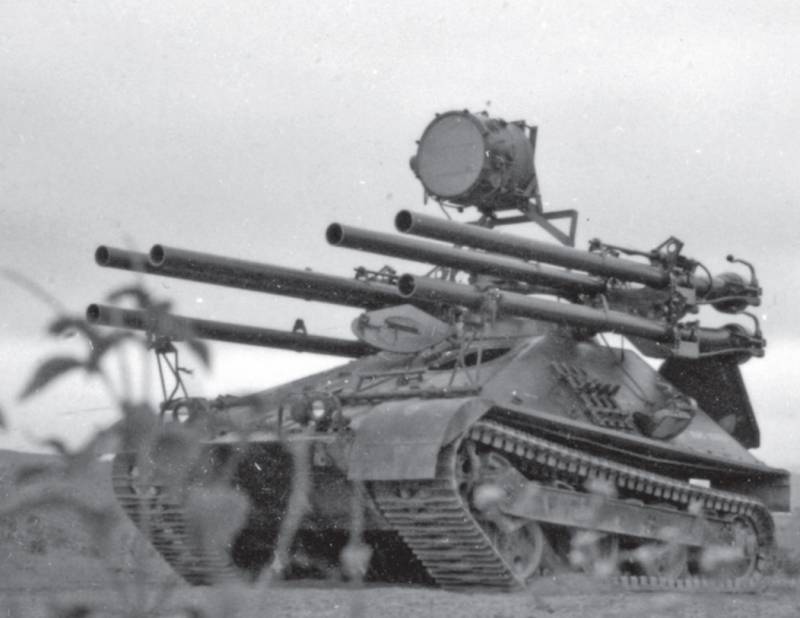
Sometimes the Ontos were used as nomadic guns, harassing enemy positions. Approaching the distance of the shot, they fired shells from the guns and quickly left the firing position. In this case, the gunner fired shots in turn or two at a time from guns spaced on different sides of the tower. Making a simultaneous salvo from six guns at once was usually avoided, since in this case everything around was clouded with smoke and dust.
Quite predictably, light self-propelled guns turned out to be very vulnerable to hand-held anti-tank grenade launchers and suffered greatly when mines exploded. After several vehicles were lost during raids to block partisan supply routes, the command limited their scope to the protection of stationary objects, where they were considered as a means of fire reinforcement.
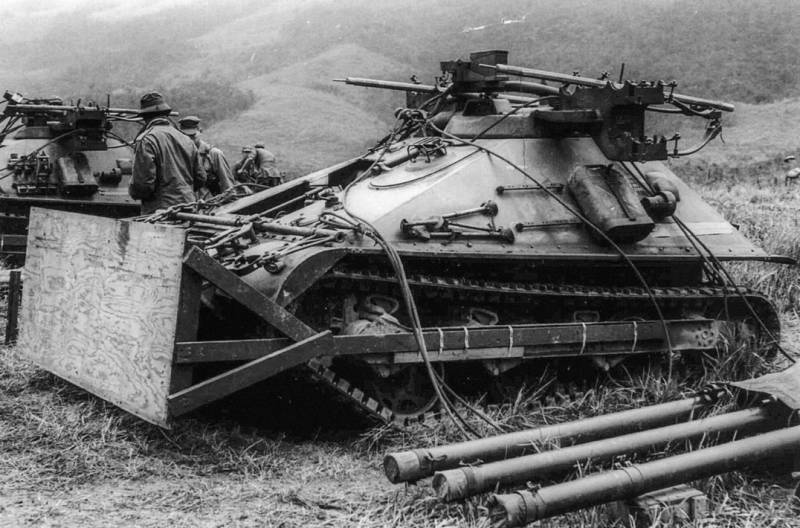
Shortly before the end of their career, several self-propelled guns were disarmed and converted into bulldozers used to clear field helipads, and into light tractors that pulled vehicles stuck on dirt roads during the rainy season.
Completion of career
After three years of combat service in Vietnam, it became difficult for the crews and mechanics of the maintenance platoons to keep the Ontos in working order. Especially a lot of complaints caused the state of the chassis. The wear and tear of machines and the lack of spare parts affected. By March 1969, most of the self-propelled guns were considered to be of limited combat readiness, were placed in stationary firing positions and were used as fixed firing points.
In May 1969, the surviving M50A1s were loaded onto ships and sent to California. The anti-tank battalions were disbanded, the crews were distributed to other units.
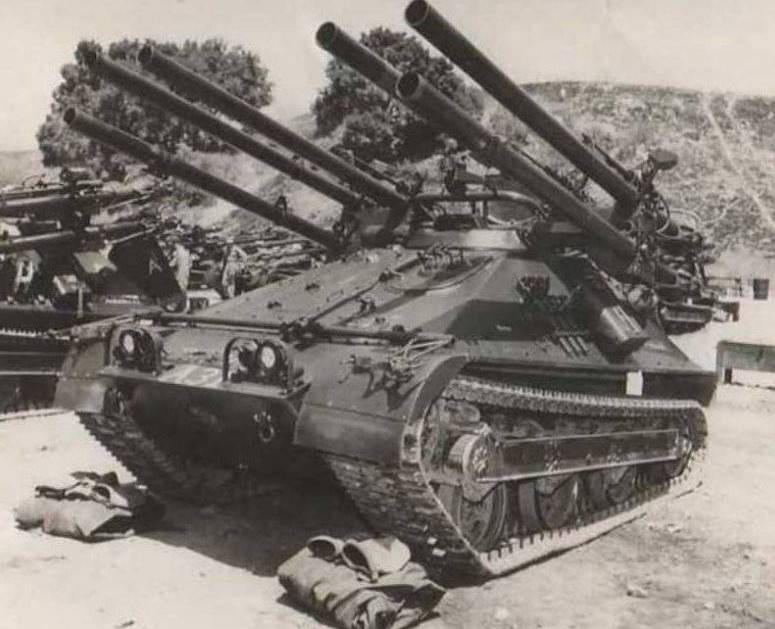
By that time, ATGMs had already appeared in the US armed forces, and self-propelled guns armed with recoilless guns were considered hopelessly outdated. In 1970, the Marine Corps decommissioned all Ontos. Most of the vehicles were cut into metal, armor was cut off from several self-propelled guns and used as tractors at airfields and storage bases, where they survived until the mid-1970s.
Information